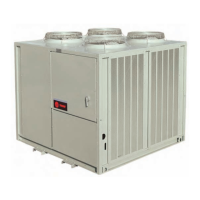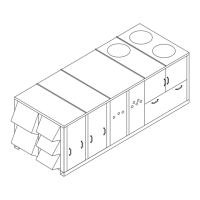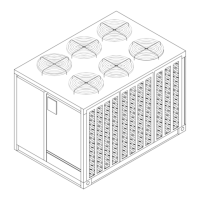CAUJ-SVX01E-EN
49
refrigeration circuit. See Component Location drawings
in the Operating Principals chapter for damper location
illustrations for the appropriate unit.
For field installation, mount the dampers over the
condenser fans at the locations shown in Component
Location drawings and connect the actuator, controller,
and sensor for each circuit. (Refer to the Installation
Instructions provided with each low ambient damper
kit.)
The controller has a factory default setpoint of 80º F.
This setpoint can be adjusted by installing a field
supplied resistor on 2TB34 in the low ambient control
panel located in the back of the main control panel.
(See the low ambient wiring diagram that shipped with
the unit or with the field kit, for resistance values and
installation location.)
WWAARRNNIINNGG
LLiivvee EElleeccttrriiccaall CCoommppoonneennttss!!
FFaaiilluurree ttoo ffoollllooww aallll eelleeccttrriiccaall ssaaffeettyy pprreeccaauuttiioonnss
wwhheenn eexxppoosseedd ttoo lliivvee eelleeccttrriiccaall ccoommppoonneennttss ccoouulldd
rreessuulltt iinn ddeeaatthh oorr sseerriioouuss iinnjjuurryy..
WWhheenn iitt iiss nneecceessssaarryy ttoo wwoorrkk wwiitthh lliivvee eelleeccttrriiccaall
ccoommppoonneennttss,, hhaavvee aa qquuaalliiffiieedd lliicceennsseedd eelleeccttrriicciiaann
oorr ootthheerr iinnddiivviidduuaall wwhhoo hhaass bbeeeenn pprrooppeerrllyy ttrraaiinneedd
iinn hhaannddlliinngg lliivvee eelleeccttrriiccaall ccoommppoonneennttss ppeerrffoorrmm
tthheessee ttaasskkss..
Inspect the damper blades for proper alignment and
operation. Dampers should be in the closed position
during the “Off” cycle.
NNOOTTIICCEE
AAccttuuaattoorr DDaammaaggee!!
DDoo nnoott ddeepprreessss aaccttuuaattoorr cclluuttcchh wwhhiillee aaccttuuaattoorr iiss
eenneerrggiizzeedd aass iitt ccoouulldd rreessuulltt iinn aaccttuuaattoorr ddaammaaggee..
If adjustment is required:
1. Remove the sensor leads from the input terminals 6
and 7 for circuit #1 and/or 11 and 12 for circuit #2.
(Controller output signal will go to 0.0 VDC and the
damper will drive to the closed position.)
2. Loosen the actuator clamp.
3. Firmly hold the damper blades in the closed
position
4. Retighten the actuator clamp.
To check damper operation, jumper between the sensor
input terminals 6 and 7 and/or 11 and 12 (if applicable).
Controller output signal will go to 10 VDC and damper
will drive to full open position.
Charging the System
1. Verify that all discharge service valves and liquid
line service valves for each circuit is back seated.
2. Attach a set of service gauges onto the liquid line
and discharge line gauge ports for each circuit.
3. Charge liquid refrigerant into the liquid line of each
refrigerant circuit with the required amount of R-
410A. Refrigerant should be charged into the
system by weight.
Use an accurate scale or a charging cylinder to
monitor the amount of refrigerant entering the
system. See Table 19, p. 50 for the recommended
refrigerant capacities for the condensing unit. The
weight of refrigerant required for the liquid line and
liquid line driers are listed in Table 20, p. 50.
If the pressure within the system equalizes with the
pressure in the charging cylinder before charging is
completed, complete the process by vapor charging
into the suction (low) side of the system after the
system has been started.
Table 21, p. 50 gives the minimum starting
temperatures for both “Standard” & “Low”
Ambient units.
Do not attempt to charge the system with the low
ambient dampers and/or hot gas bypass operating
(if applicable). Disable the low ambient dampers in
the “Open” position (refer to the “Low Ambient
Damper Adjustment” section) and de-energize the
hot gas bypass solenoid valves before proceeding.
4. On units with dual circuits, start only one circuit at a
time. To disable the second circuit compressors,
refer to the compressor sequencing information
that shipped with the compressor unit.
5. With the compressors operating, slowly open the
“Low Side” valve on the manifold gauge set. The
remainder of the refrigerant will be drawn into the
system.
6. Once the charging for the operating circuit has been
completed, check and record the:
• ambient temperature;
• compressor oil level (each circuit); compressor
suction and discharge pressures (each circuit);
• superheat and subcooling (each circuit);
Record this data on an “operator’s maintenance
log” like the one shown in Table 22, p. 51. If the
operating pressures indicate a refrigerant shortage,
measure the system superheat and system
subcooling. Repeat steps 1 through 6 for the second
refrigeration circuit, if applicable.
SSttaarrtt--UUpp

